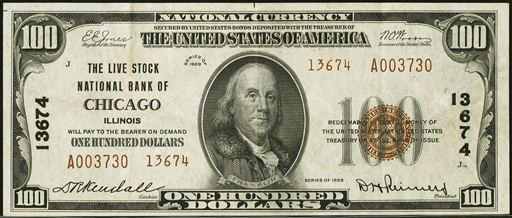The Farmers & Merchants National Bank Of Cambridge
The Farmers & Merchants National Bank Of Cambridge in Maryland printed $872,400 dollars worth of national currency. That is a high amount, but condition and serial numbers can make otherwise common currency from this bank quite valuable. This national bank opened in 1901 and stopped printing money in 1935, which equals a 35 year printing period. That is a fairly normal lifespan for a national bank. During its life, The Farmers & Merchants National Bank Of Cambridge issued 10 different types and denominations of national currency. We have examples of the types listed below. Your bank note should look similar. Just the bank name will be different. For the record, The Farmers & Merchants National Bank Of Cambridge was located in Dorchester County. It was assigned charter number 5880.
We buy all national currency. Please call or email us for a quote. Sales@AntiqueMoney.com
The Farmers & Merchants National Bank Of Cambridge in Maryland printed 1,520 sheets of $50 1882 brown back national bank notes. Not many banks printed $50 1882 brown backs. Sheet outputs aren’t extremely important. However, it is good factual information to know. The most common 1882 $50 brown backs are worth about $5,000. However, some can be worth more than $10,000 based on condition, serial number, and bank of issue.
Series of 1882 $50 Brown Back
The Farmers & Merchants National Bank Of Cambridge printed 1,520 sheets of $100 1882 brown back national bank notes. Just because this bank printed more than 1,000 one hundred dollar brown backs does not mean that they are all common. We are very interested in purchasing $100 1882 brown back national bank notes. We have paid more than $15,000 for some examples. Send us pictures of what you have and we will respond quickly with an appraisal and offer.
Series of 1882 $100 Brown Back
The Farmers & Merchants National Bank Of Cambridge also printed 1,046 sheets of $50 1882 blue seal national bank notes. High denomination 1882 blue seals like this are not frequently encountered, regardless of the number of notes printed. There is a big difference between the two types of 1882 $50 blue seals. The variety that says “1882-1908” on the back is rare, but no where near as rare at the type that says “Fifty Dollars.” The second variety is extremely rare and only about a half dozen are known to exist. The first type should still be worth at least $4,000. The second type is a five figure rarity though.
1882 Blue Seal $50 National Bank Note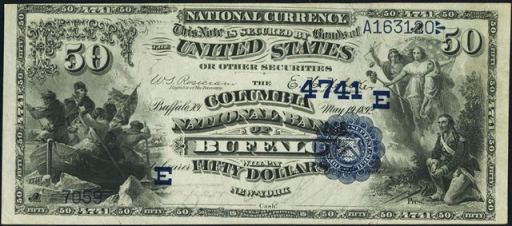
The Farmers & Merchants National Bank Of Cambridge also printed 1,046 sheets of $100 1882 blue seal national bank notes. The number of sheets printed doesn’t matter too much here. All 1882 $100 blue seals are rare. They were issued by a total of 256 total national banks in the country. The rare 1882 value backs were only printed by banks in Dayton, Ohio and New Orleans, Louisiana. The slightly more common date backs are much more plentiful but still rare in the scheme of things.
1882 Blue Seal $100 National Bank Note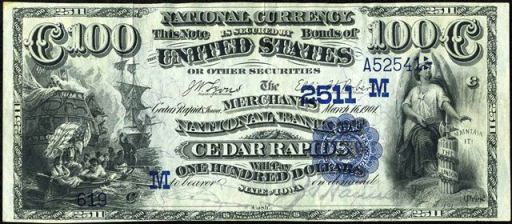
The Farmers & Merchants National Bank Of Cambridge also printed 787 sheets of $50 1902 blue seal national bank notes. There is no trick to knowing which 1902 blue seals will be common and rare. Often times the number printed won’t tell you much information. The value still comes down to condition and demand. That is a surprise to most people. In fact, most 1902 $50 bills we see are worth between $750 and $1,250. The rarer ones can be worth more than $5,000. However, there isn’t much middle ground.
1902 $50 Blue Seal National Bank Note
The Farmers & Merchants National Bank Of Cambridge also printed 787 sheets of $100 1902 blue seal national bank notes. It is no coincidence that the sheet numbers for $50 bills and $100 bills are the same. They were printed on the same sheets. Most $100 blue seals are at least scarce; others can be very rare. John J Knox is printed on the front of each bill. Most collectors like the back design a lot more though. It is really unique and different from most other national bank notes. Prices for 1902 $100 blue seals are pretty similar to $50 blue seals. They are both equally common or equally rare, depending on how you look at it.
1902 $100 Blue Seal National Bank Note
The Farmers & Merchants National Bank Of Cambridge also printed 186 sheets of Type1 1929 $50 national bank notes. That is an extremely small sheet printing number. Survivors are still likely but definitely not guaranteed. As is the case with all modern fifty dollar bills, Ulysses Grant is pictured on the front of 1929 $50 bills. This is a higher denomination that was only printed by 300 different national banks. Many examples are only worth around a few hundred dollars. Rarer specimens can sell for more than $1,000.
Series of 1929 Type1 $50 National Bank Note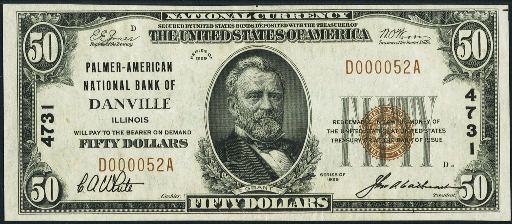
The Farmers & Merchants National Bank Of Cambridge also printed 64 sheets of Type1 1929 $100 national bank notes. That is an extremely small sheet printing number. Survivors are still likely but definitely not guaranteed. Despite saying series of 1929, all type1 national bank notes were actually printed between 1929 and 1933. Exactly 289 national banks printed $100 type1 notes. Most are relatively common. However, as with anything, there are always exceptions to that rule.
Series of 1929 Type1 $100 National Bank Note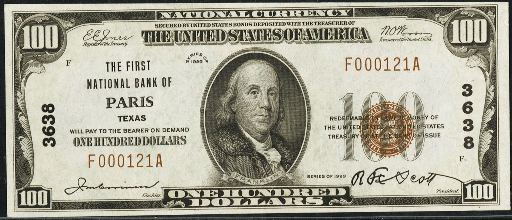
The Farmers & Merchants National Bank Of Cambridge also printed 89 individual notes from the type2 1929 $50 national bank note series. Type2 1929 national bank notes are already rare to begin with. A printing of less than 1,000 is especially low. Type2 fifty dollar national bank notes were only printed between 1933 and 1935. Obviously, that is a very short production window. Only 51 national banks in the country printed this type of bank note.
Series of 1929 Type2 $50 National Bank Note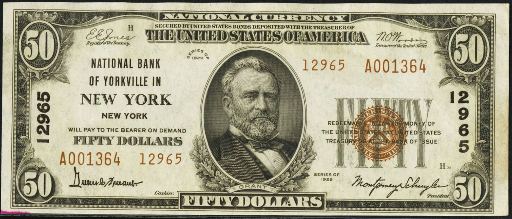
The Farmers & Merchants National Bank Of Cambridge also printed 35 individual notes from the type2 1929 $100 national bank note series. Type2 1929 national bank notes are already rare to begin with. A printing of less than 1,000 is especially low. Surprisingly, only 38 different national banks issued type2 $100 bills. Over 300 are known to exist from all banks in the country, so it isn’t exactly a traditional rarity, but it does have good stats. Just like every $100 bill printed since 1928, these notes also feature a portrait of Benjamin Franklin.
Series of 1929 Type2 $100 National Bank Note